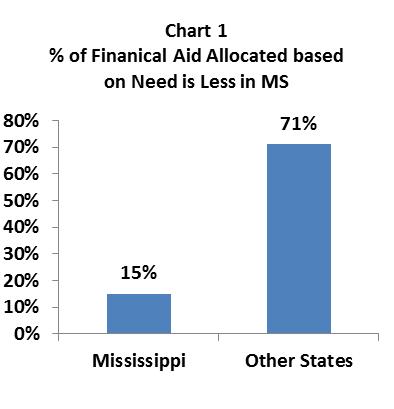Financial Aid Key to Mississippi Higher Education Future
December 2nd, 2013
 Last week, I wrote about some of the hurdles Mississippians face in pursuing a post-secondary credential. Key to this discussion is the element of financial aid, which is often a determining factor in the decision to not only persist, but also whether they pursue a credential in the first place. When the Mississippi Graduation Task Force met andissued its goals and recommendations in 2009, expectations were raised for not only students and Mississippi’s Institutions of Higher Learning, but also for policymakers around the state. Has Mississippi’s financial aid system upgraded itself to meet the challenge?
Last week, I wrote about some of the hurdles Mississippians face in pursuing a post-secondary credential. Key to this discussion is the element of financial aid, which is often a determining factor in the decision to not only persist, but also whether they pursue a credential in the first place. When the Mississippi Graduation Task Force met andissued its goals and recommendations in 2009, expectations were raised for not only students and Mississippi’s Institutions of Higher Learning, but also for policymakers around the state. Has Mississippi’s financial aid system upgraded itself to meet the challenge?
Mississippi’s three primary state-funded grants received a total of $21.9 million in 2012. After adjusting for inflation, the state distributed 17% less for these programs than a decade earlier. In addition to distributing less money overall, Mississippi does a poor job of targeting its aid to those who need it most. As Chart 1 shows, of the grant funds available, only 15% of Mississippi’s financial aid dollars are awarded on the basis of need – this same rate is 71% nationally.
Need-based funding comes through the Higher Education Legislative Program (HELP). HELP is a financial aid program designed to provide tuition assistance to qualified students. HELP has high school curriculum requirements, an ACT requirement of at least 20, and an earlier application deadline than Mississippi’s other state-aid programs. This advanced deadline coupled with low promotion of the program has resulted in fewer students applying for HELP.
What do these figures ultimately mean for Mississippi? From the student perspective, research shows that financial aid can have a positive effect on graduation and persistence of students in higher education. It follows, then, that a strengthened financial aid system will ultimately result in higher completion rates. Further, from an economic perspective, most of Mississippi’s neighbors spend a larger portion of funds on state grant aid. To compete with other states, a career ready workforce is essential. The end result is better jobs and economic opportunity for everyone.
To bridge the financial aid gap, there are a number of avenues Mississippi can take to make its financial aid system more robust for its students. First, Mississippi must increase the amount of grant funds dedicated to need-based financial aid. Once increased, programs should be structured so that for those who are most in need and able to take college classes, that the cost of attendance is not an impediment to enrollment and completion. Second, non-traditional students should also be eligible for some type of financial aid to ease the transition back to school. Both recommendations broaden and deepen the resources available to Mississippi’s students and increase the likelihood that more of its people will progress along a productive career pathway.






